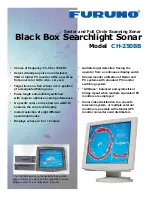
Oculus M-Series Sonar
User Manual
22
3.8.
Summary of Sonar Operation
In general, the following points summarise operation of the sonar:
The sonar image shows “top
-
down” type display of the echoes received from the targets leading edges.
Only targets illuminated by the sonar beam can be seen:
o
130°/80° in the horizontal plane depending on frequency mode
o
20°/12° vertically although this is the half-power point and fainter targets may appear outside
this.
As no vertical information is available, vertically aligned or overlapping targets in the sonar beam will
merge into a single echo.
Dense or gaseous targets appear brightest on the display, while mud and silt will appear very dull.
Targets cast acoustic shadows, which may obscure all or parts of targets behind them especially as the
sonar approaches them.
Change altitude above the seabed to change the angle of illumination for targets, and the length of the
shadows they cast
–
this can help interpret features on the sonar image.
Use the gain control to enhance faint targets or reduce the background noise reflections in a high clutter
(rocky/boulder) environment.
Where possible, use different frequency modes depending on required range and detail level:
o
Low Frequency mode for a wide viewing angle (130°) with the longest ranges supported by the
sonar.
o
High Frequency mode for detailed high resolution imagery, but reduced viewing angle (80°) and
shorter range settings.
For navigating or surveying the seabed, mount the sonar horizontally pointing forwards with a slight
down angle (10-15°).
While gaining experience using the sonar, a good rule-of-thumb for optimal seabed coverage on the
display is to aim to maintain a seabed altitude of approximately 10% of the selected sonar range.
For accurate calibration of ranges, check the correct water salinity has been entered into the software
for the operating site.



























